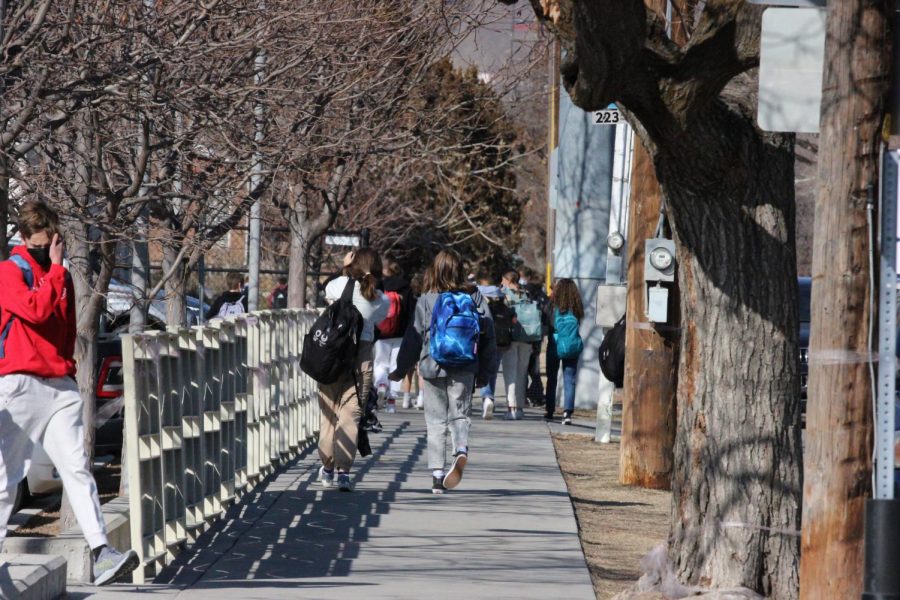Convenient School Boundaries Create Inequality
Students in the SLC School District walk home from school.
February 24, 2022
School segregation on the basis of race was declared illegal in 1954 with the completion of Brown v. Board of Education.
Despite the elimination of blatant segregation in schools, the reality is that years of structural racism—in the form of redlining and the racist architecture of real estate—have prolonged school segregation on the basis of socioeconomics and race. In a phrase coined by the New York Times: we are “still separate, still unequal.”
Today, school district boundaries across the nation reinforce this segregation and these boundaries—however innocently drawn—act as a brick wall between communities.
US News emphasizes this phenomenon: “Nearly 1,000 school district boundaries separate communities where students are significantly more white and wealthy from communities where students are significantly more black and Latino and poor, a new study shows,” the article said.
As far as the Salt Lake City School District goes, elementary schools are based in local communities. While this may be a matter of convenience, the consequences of such an action need to be recognized.
When we inadvertently segregate by socioeconomic status by valuing convenience over diversity, we are actively contributing to educational inequality and the elements of segregation that still exist in our nation today.
At our local elementary schools, income demographics illustrate a lack of diversity. The SLCSD Income Report from Fall 2021 shows nine schools with a low-income rate below 25%. Comparatively, 11 schools have a rate above 75%. Six have a low-income student population below 15% and five have a 100% low-income rate.
Thomas Luthy, an elementary school principal in the district, has seen the correlation between low-income populations and success.
“You hear a lot of people say that your schooling shouldn’t be affected by your zip code,” Luthy said. “If you look at the outcomes, there is a strong correlation between SES [socioeconomic standing] and student performance. [Schools with] 100% free and reduced lunch have a lot more challenges, and so the student outcomes generally are not as high.”
The socioeconomic segregation perpetuated by school boundaries is obvious. On a national scale, the negative effects of such a phenomenon have been proven.
“Of the 13 school districts that surround Philadelphia [School District], two-thirds are at least 25 percentage points whiter and have at least 10 percent more funding for their schools than the city schools – equating to an average of $5,000 or more in per-pupil funding,” US News, 2019 said. “One of those districts, Lower Merion, is 60% whiter than Philadelphia and students there receive $30,000 more per student. In Philadelphia, 86% of students are non-white.”
In our community, we have to recognize that funding from students’ families in more economically benefited areas is another issue to contend with. There is a clear imbalance of access to resources from home, regardless of the government funding a school may receive.
Even aside from questions of segregation, there is certainly something to be said for the benefits of growing up with economically and racially diverse peers—especially for young children.
When Brown v. Board of Education first passed, the congressionally authorized report stated that “socioeconomic school integration could increase academic achievement more than any other school strategy.”
Fifty years ago, federal judges drew school boundaries in order to achieve racial balance. Children travelled across town and, unsurprisingly, parents rebelled.
Today, convenience and transportation are undeniably important considerations. However, we must recognize what our priorities are.
By prioritizing convenience over true integration, we are putting our children, and their academic and social development, at a disadvantage.
In the Salt Lake City School District, where high schools integrate students of many racial and socioeconomic backgrounds, there remains a problem at the elementary level.
Elementary-aged children are at a very impressionable age and point in their life and integration is crucial to all.
On an academic level, statistics notably improve in diverse educational environments. A study cited from The Century Foundation states that students growing up in integrated schools are 68% more likely to enroll in a four-year university than their peers in high-poverty schools.
The same source emphasizes that integrated schools actively help reduce the racial achievement gap. A study in Montgomery County, Maryland determined that integrated schools outperformed even schools that ultimately received higher public funding per pupil.
“The gap in SAT scores between black and white students continues to be larger in segregated districts, and one study showed that change from complete segregation to complete integration in a district could reduce as much as one quarter of the current SAT score disparity,” The Century Foundation said. “A recent study from Stanford’s Center for Education Policy Analysis confirmed that school segregation is one of the most significant drivers of the racial achievement gap.”
There is then a resounding concern from families. Every engaged parent wants their children to attend a school that provides a safe environment for academic achievement. Every child deserves this.
It is for this exact reason that parents should want their children to attend racially and economically diverse schools.
In a nation where implicit bias is an ongoing issue, “children are at risk of developing stereotypes about racial groups if they live in and are educated in racially isolated settings,” (The Century Foundation).
Alternatively, children growing up in diverse environments have been proven to be subjects of a significant reduction in discriminatory attitudes and prejudices towards children of other racial groups.
Principal Luthy reiterated these benefits.
“I think it [diversity] is huge,” Luthy said. “It’s a big part of not only understanding other people, but understanding yourself.”
The proposal of radical integration is not without its complexities, as transporting children further distances to get to school raises economic concerns. However, I believe that it remains a crucial conversation to be had and an infinitely valuable commitment for our children.
Diversity strengthens children and prepares them for the globalized and multi-cultured world we live in. Monoculture—as enabled by economically segregated elementary schools in our community—leaves room for potential racial stigmatization, development of implicit biases, and perpetuates educational inequality.
As we strive to prepare and enrich the minds of the future generation of lawmakers, leaders, and citizens, we must recognize what is best for the academic and social development of children. Active efforts we make towards integrative policies may require sacrifices as far as convenience and the locality of schools. But the reality is that the environments children grow up in shape their views on the world for the rest of their lives.
It is time to fight implicit bias. It is time to implement genuine educational equality. It may require discomfort, but—ultimately—these goals can only be achieved by making diversity a number one priority.





























